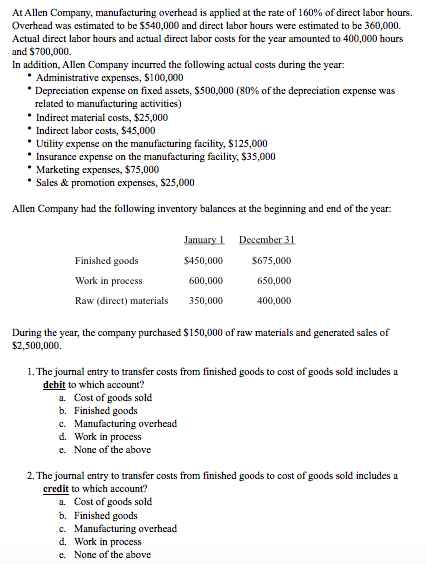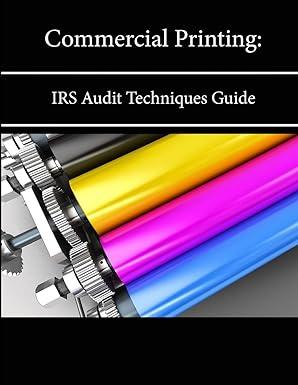 No explanation necessary
No explanation necessary
At Allen Company, manufacturing overhead is applied at the rate of 160% of direct labor hours. Overhead was estimated to be $540,000 and direct labor hours were estimated to be 360,000. Actual direct labor hours and actual direct labor costs for the year amounted to 400,000 hours and $700,000. In addition, Allen Company incurred the following actual costs during the year: Administrative expenses, $100,000 Depreciation expense on fixed assets, $500,000 (80% of the depreciation expense was related to manufacturing activities) Indirect material costs, $25,000 Indirect labor costs, $45,000 Utility expense on the manufacturing facility, $125,000 Insurance expense on the manufacturing facility, S35,000 Marketing expenses, $75,000 Sales & promotion expenses, $25,000 Allen Company had the following inventory balances at the beginning and end of the year: January 1 $450,000 Finished goods Work in process Raw (direct) materials December 31 $675,000 650,000 600,000 350,000 400,000 During the year, the company purchased $150,000 of raw materials and generated sales of $2,500,000. 1. The journal entry to transfer costs from finished goods to cost of goods sold includes al debit to which account? a. Cost of goods sold b. Finished goods c. Manufacturing overhead d. Work in process e. None of the above 2. The journal entry to transfer costs from finished goods to cost of goods sold includes al credit to which account? a. Cost of goods sold b. Finished goods c. Manufacturing overhead d. Work in process e. None of the above 3. Refer to the previous two questions. The amount of the entry is: 4. The journal entry at the end of the period to adjust for over- or under-applied overhead will include a: a. Debit to Selling, General and Administrative expenses b. Credit to Finished Goods c. Debit to Cost of goods sold d. Credit to Cost of goods sold e. None of the above 5. Refer to the previous question. The amount of the entry is: At Allen Company, manufacturing overhead is applied at the rate of 160% of direct labor hours. Overhead was estimated to be $540,000 and direct labor hours were estimated to be 360,000. Actual direct labor hours and actual direct labor costs for the year amounted to 400,000 hours and $700,000. In addition, Allen Company incurred the following actual costs during the year: Administrative expenses, $100,000 Depreciation expense on fixed assets, $500,000 (80% of the depreciation expense was related to manufacturing activities) Indirect material costs, $25,000 Indirect labor costs, $45,000 Utility expense on the manufacturing facility, $125,000 Insurance expense on the manufacturing facility, S35,000 Marketing expenses, $75,000 Sales & promotion expenses, $25,000 Allen Company had the following inventory balances at the beginning and end of the year: January 1 $450,000 Finished goods Work in process Raw (direct) materials December 31 $675,000 650,000 600,000 350,000 400,000 During the year, the company purchased $150,000 of raw materials and generated sales of $2,500,000. 1. The journal entry to transfer costs from finished goods to cost of goods sold includes al debit to which account? a. Cost of goods sold b. Finished goods c. Manufacturing overhead d. Work in process e. None of the above 2. The journal entry to transfer costs from finished goods to cost of goods sold includes al credit to which account? a. Cost of goods sold b. Finished goods c. Manufacturing overhead d. Work in process e. None of the above 3. Refer to the previous two questions. The amount of the entry is: 4. The journal entry at the end of the period to adjust for over- or under-applied overhead will include a: a. Debit to Selling, General and Administrative expenses b. Credit to Finished Goods c. Debit to Cost of goods sold d. Credit to Cost of goods sold e. None of the above 5. Refer to the previous question. The amount of the entry is
 No explanation necessary
No explanation necessary






